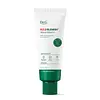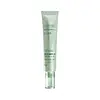What's inside
What's inside
 Key Ingredients
Key Ingredients

 Benefits
Benefits

 Concerns
Concerns

 Ingredients Side-by-side
Ingredients Side-by-side

Water
Skin ConditioningDipropylene Glycol
HumectantButylene Glycol
HumectantPhenyl Trimethicone
Skin ConditioningTriethylhexanoin
MaskingVinyldimethicone
Cetearyl Alcohol
EmollientPanthenol
Skin ConditioningNiacinamide
SmoothingPCA Dimethicone
Skin ConditioningPolyglyceryl-3 Methylglucose Distearate
Emulsifying1,2-Hexanediol
Skin ConditioningC14-22 Alcohols
Emulsion StabilisingGlyceryl Stearate Se
EmulsifyingAmmonium Acryloyldimethyltaurate/Vp Copolymer
Glycerin
HumectantCetearyl Olivate
Sorbitan Olivate
EmulsifyingMadecassoside
AntioxidantC12-20 Alkyl Glucoside
EmulsifyingCaprylyl Glycol
EmollientRaffinose
Skin ConditioningXanthan Gum
EmulsifyingMelia Azadirachta Leaf Extract
Skin ConditioningEthylhexylglycerin
Skin ConditioningDipotassium Glycyrrhizate
HumectantMelia Azadirachta Flower Extract
Skin ConditioningAsiaticoside
AntioxidantDisodium EDTA
Coccinia Indica Fruit Extract
Skin ConditioningCentella Asiatica Leaf Extract
Skin ConditioningHydrolyzed Hibiscus Esculentus Extract
Skin ConditioningLupinus Albus Seed Extract
Skin ConditioningMoringa Oleifera Seed Extract
Skin ConditioningAmber Powder
Solanum Melongena Fruit Extract
Skin ConditioningPinus Sylvestris Bud Extract
PerfumingCurcuma Longa Root Extract
MaskingOcimum Sanctum Leaf Extract
Skin ConditioningCorallina Officinalis Extract
Skin ConditioningMoringa Oleifera Seed Oil
EmollientAsiatic Acid
Skin ConditioningMadecassic Acid
Skin ConditioningMethylpropanediol
SolventEpigallocatechin Gallate
AntioxidantPyrus Malus Fruit Extract
Skin ConditioningBeta-Glucan
Skin ConditioningCentella Asiatica Extract
CleansingWater, Dipropylene Glycol, Butylene Glycol, Phenyl Trimethicone, Triethylhexanoin, Vinyldimethicone, Cetearyl Alcohol, Panthenol, Niacinamide, PCA Dimethicone, Polyglyceryl-3 Methylglucose Distearate, 1,2-Hexanediol, C14-22 Alcohols, Glyceryl Stearate Se, Ammonium Acryloyldimethyltaurate/Vp Copolymer, Glycerin, Cetearyl Olivate, Sorbitan Olivate, Madecassoside, C12-20 Alkyl Glucoside, Caprylyl Glycol, Raffinose, Xanthan Gum, Melia Azadirachta Leaf Extract, Ethylhexylglycerin, Dipotassium Glycyrrhizate, Melia Azadirachta Flower Extract, Asiaticoside, Disodium EDTA, Coccinia Indica Fruit Extract, Centella Asiatica Leaf Extract, Hydrolyzed Hibiscus Esculentus Extract, Lupinus Albus Seed Extract, Moringa Oleifera Seed Extract, Amber Powder, Solanum Melongena Fruit Extract, Pinus Sylvestris Bud Extract, Curcuma Longa Root Extract, Ocimum Sanctum Leaf Extract, Corallina Officinalis Extract, Moringa Oleifera Seed Oil, Asiatic Acid, Madecassic Acid, Methylpropanediol, Epigallocatechin Gallate, Pyrus Malus Fruit Extract, Beta-Glucan, Centella Asiatica Extract
Water
Skin ConditioningGlycerin
HumectantButylene Glycol
HumectantPentaerythrityl Tetraethylhexanoate
EmollientCaprylic/Capric Triglyceride
MaskingPropanediol
SolventPolyglyceryl-6 Stearate
Emollient1,2-Hexanediol
Skin ConditioningNiacinamide
SmoothingCyclohexasiloxane
EmollientCetearyl Alcohol
EmollientTriethylhexanoin
MaskingSynthetic Beeswax
Emulsion StabilisingGlyceryl Stearate
EmollientPhytosteryl/Isostearyl/Cetyl/Stearyl/Behenyl Dimer Dilinoleate
Skin ConditioningDimethyl Isosorbide
SolventSodium Polyacryloyldimethyl Taurate
Emulsion StabilisingPolyglyceryl-6 Behenate
Emulsion StabilisingEthylhexylglycerin
Skin ConditioningHydroxypinacolone Retinoate
Skin ConditioningCentella Asiatica Extract
CleansingAdenosine
Skin ConditioningSodium Hyaluronate
HumectantHibiscus Sabdariffa Flower Extract
Skin ConditioningViola Tricolor Extract
EmollientLavandula Angustifolia Flower Extract
CleansingCentaurea Cyanus Flower Extract
AstringentBakuchiol
AntimicrobialPolysorbate 20
EmulsifyingRetinol
Skin ConditioningHydrolyzed Collagen
EmollientBHT
AntioxidantMadecassoside
AntioxidantMadecassic Acid
Skin ConditioningAsiaticoside
AntioxidantAsiatic Acid
Skin ConditioningPropolis Extract
Skin ConditioningBHA
AntioxidantDisodium EDTA
Parfum
MaskingWater, Glycerin, Butylene Glycol, Pentaerythrityl Tetraethylhexanoate, Caprylic/Capric Triglyceride, Propanediol, Polyglyceryl-6 Stearate, 1,2-Hexanediol, Niacinamide, Cyclohexasiloxane, Cetearyl Alcohol, Triethylhexanoin, Synthetic Beeswax, Glyceryl Stearate, Phytosteryl/Isostearyl/Cetyl/Stearyl/Behenyl Dimer Dilinoleate, Dimethyl Isosorbide, Sodium Polyacryloyldimethyl Taurate, Polyglyceryl-6 Behenate, Ethylhexylglycerin, Hydroxypinacolone Retinoate, Centella Asiatica Extract, Adenosine, Sodium Hyaluronate, Hibiscus Sabdariffa Flower Extract, Viola Tricolor Extract, Lavandula Angustifolia Flower Extract, Centaurea Cyanus Flower Extract, Bakuchiol, Polysorbate 20, Retinol, Hydrolyzed Collagen, BHT, Madecassoside, Madecassic Acid, Asiaticoside, Asiatic Acid, Propolis Extract, BHA, Disodium EDTA, Parfum
 Reviews
Reviews

Alternatives
Ingredients Explained
These ingredients are found in both products.
Ingredients higher up in an ingredient list are typically present in a larger amount.
1,2-Hexanediol is a synthetic liquid and another multi-functional powerhouse.
It is a:
- Humectant, drawing moisture into the skin
- Emollient, helping to soften skin
- Solvent, dispersing and stabilizing formulas
- Preservative booster, enhancing the antimicrobial activity of other preservatives
Asiatic Acid is a major component of Centella Asiatica Extract. It has wound-healing, anti-inflammatory, and antioxidant properties.
Studies show Asiatic Acid is able to block the pathway for skin inflammation receptors, helping to soothe skin.
As an antioxidant, asiatic acid helps protect our skin against damaging environmental factors.
Learn more about Asiatic AcidAsiaticoside comes from the super popular skin-soothing ingredient, Centella asiatica. It is one of four active compounds found in the extract of Centella Asiatica.
Asiaticoside is an antioxidant and helps with wound healing. It has been shown to increase antioxidant activity during the wound healing process.
Butylene Glycol (or BG) is used within cosmetic products for a few different reasons:
Overall, Butylene Glycol is a safe and well-rounded ingredient that works well with other ingredients.
Though this ingredient works well with most skin types, some people with sensitive skin may experience a reaction such as allergic rashes, closed comedones, or itchiness.
Learn more about Butylene GlycolCentella Asiatica Extract (Centella) is derived from an herb native to Southeast Asia. It is famous for its anti-inflammatory and soothing properties.
Centella is rich in antioxidants and amino acids, such as Madecassic Acid and Asiaticoside.
Studies show the compounds in centella help with:
The combination of all these properties makes centella effective at soothing, hydrating, and protecting the skin.
Other great components of centella include Vitamin A, vitamin C, several B vitamins, and Asiatic Acid.
Fun fact: Centella has been used as a medicine and in food for many centuries. As a medicine, it is used to treat burns, scratches, and wounds.
Learn more about Centella Asiatica ExtractCetearyl alcohol is a mixture of two fatty alcohols: cetyl alcohol and stearyl alcohol. It is mainly used as an emulsifier. Emulsifiers help prevent the separation of oils and products. Due to its composition, it can also be used to thicken a product or help create foam.
Cetearyl alcohol is an emollient. Emollients help soothe and hydrate the skin by trapping moisture.
Studies show Cetearyl alcohol is non-toxic and non-irritating. The FDA allows products labeled "alcohol-free" to have fatty alcohols.
This ingredient is usually derived from plant oils such as palm, vegetable, or coconut oils. There is debate on whether this ingredient will cause acne.
Due to the fatty acid base, this ingredient may not be Malassezia folliculitis safe.
Learn more about Cetearyl AlcoholDisodium EDTA plays a role in making products more stable by aiding other preservatives.
It is a chelating agent, meaning it neutralizes metal ions that may be found in a product.
Disodium EDTA is a salt of edetic acid and is found to be safe in cosmetic ingredients.
Learn more about Disodium EDTAEthylhexylglycerin (we can't pronounce this either) is commonly used as a preservative and skin softener. It is derived from glyceryl.
You might see Ethylhexylglycerin often paired with other preservatives such as phenoxyethanol. Ethylhexylglycerin has been found to increase the effectiveness of these other preservatives.
Glycerin is already naturally found in your skin. It helps moisturize and protect your skin.
A study from 2016 found glycerin to be more effective as a humectant than AHAs and hyaluronic acid.
As a humectant, it helps the skin stay hydrated by pulling moisture to your skin. The low molecular weight of glycerin allows it to pull moisture into the deeper layers of your skin.
Hydrated skin improves your skin barrier; Your skin barrier helps protect against irritants and bacteria.
Glycerin has also been found to have antimicrobial and antiviral properties. Due to these properties, glycerin is often used in wound and burn treatments.
In cosmetics, glycerin is usually derived from plants such as soybean or palm. However, it can also be sourced from animals, such as tallow or animal fat.
This ingredient is organic, colorless, odorless, and non-toxic.
Glycerin is the name for this ingredient in American English. British English uses Glycerol/Glycerine.
Learn more about GlycerinMadecassic Acid is a major component of Centella Asiatica Extract. It has anti-inflammatory and antioxidant properties.
It is a triterpenoid, meaning it naturally acts as an antioxidant. Antioxidants protect your skin against damage from environmental factors such as pollution and UV.
Studies show Madecassic Acid helps soothe the skin due to its ability to block inflammation pathways.
Learn more about Madecassic AcidMadecassoside comes from the super popular skin-soothing ingredient, Centella asiatica. It is one of four active compounds found in the extract of Centella Asiatica.
Madecassoside has antioxidant, anti-inflammatory, and hydrating properties. It contains fatty acids, amino acids, beta-carotene, and phytochemicals.
One study found using Madecassoside with ascorbic acid helped reduce the signs of aging and improved skin hydration.
Learn more about MadecassosideNiacinamide is a multitasking form of vitamin B3 that strengthens the skin barrier, reduces pores and dark spots, regulates oil, and improves signs of aging.
And the best part? It's gentle and well-tolerated by most skin types, including sensitive and reactive skin.
You might have heard of "niacin flush", or the reddening of skin that causes itchiness. Niacinamide has not been found to cause this.
In very rare cases, some individuals may not be able to tolerate niacinamide at all or experience an allergic reaction to it.
If you are experiencing flaking, irritation, and dryness with this ingredient, be sure to double check all your products as this ingredient can be found in all categories of skincare.
When incorporating niacinamide into your routine, look out for concentration amounts. Typically, 5% niacinamide provides benefits such as fading dark spots. However, if you have sensitive skin, it is better to begin with a smaller concentration.
When you apply niacinamide to your skin, your body converts it into nicotinamide adenine dinucleotide (NAD). NAD is an essential coenzyme that is already found in your cells as "fuel" and powers countless biological processes.
In your skin, NAD helps repair cell damage, produce new healthy cells, support collagen production, strengthen the skin barrier, and fight environmental stressors (like UV and pollution).
Our natural NAD levels start to decline with age, leading to slower skin repair, visible aging, and a weaker skin barrier. By providing your skin niacinamide, you're recharging your skin's NAD levels. This leads to stronger, healthier, and younger looking skin.
Another name for vitamin B3 is nicotinamide. This vitamin is water-soluble and our bodies don't store it. We obtain Vitamin B3 from either food or skincare. Meat, fish, wheat, yeast, and leafy greens contain vitamin B3.
The type of niacinamide used in skincare is synthetically created.
Learn more about NiacinamideTriethylhexanoin is created from glycerin and 2-ethylhexanoic acid. It is a solvent and emollient.
As a solvent, Triethylhexanoin helps dissolve ingredients to stable bases or help evenly distribute ingredients throughout the product.
It is also an emollient and helps condition the skin.
Learn more about TriethylhexanoinWater. It's the most common cosmetic ingredient of all. You'll usually see it at the top of ingredient lists, meaning that it makes up the largest part of the product.
So why is it so popular? Water most often acts as a solvent - this means that it helps dissolve other ingredients into the formulation.
You'll also recognize water as that liquid we all need to stay alive. If you see this, drink a glass of water. Stay hydrated!
Learn more about Water